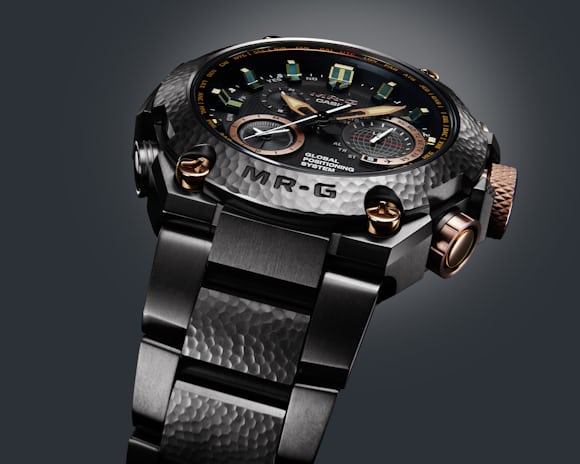If there were a search for the last honest watch on Earth – a watch that embodies down to the deepest fiber of its being what it really means to be a genuine tool watch, and not just a (generally overpriced) illustration of what a tool watch used to be, chances are very good that it would be a Casio G-Shock. Unloved by many who think of themselves as real watch lovers, the G-Shock is very much loved by those who need a watch that will put up with the very roughest use the very roughest and most dangerous jobs can dish out. G-Shocks are worn by more than a few hipsters and would-be hipsters these days, but they're also worn by the thousands by police officers, firefighters, special forces operators, regular Army guys and gals – you name it. A $150 Tough Solar G-Shock will last basically indefinitely and will as for absolutely nothing in return for flawless performance other than that you don't expose it to a nuclear explosion. So what the heck is Casio doing in offering a $6,200 G-Shock?

The G-Shock was never an especially inexpensive watch by design, although it was certainly, at least as originally conceived, designed to work for a living rather than get by on its looks. Its prices have therefore generally reflected its status as a tool, rather than as a design or display object. As the years have gone by, however (the very first G-Shock debuted in 1982) they have not only become collectible, with many, many serious G-Shock enthusiasts around the world as fanatical and focused as any Patek-aholic or Rolex aficionado, but they've also become gradually more culturally iconic and symbolic as well. The luxury-priced (for G-Shocks, anyway) MR-G series have pushed the high end of G-Shock prices north of $1,000, and this limited edition – created to celebrate the 20th anniversary of MR-G – goes even further.
The Hammer Tone (or to give it its proper name, the MRGG1000HT) is one of those mash-ups of pop culture and tradition that seems so highly characteristic of Japanese culture. The Hammer Tone is a G-Shock through and through, of course – it's water resistant (200 m), shock resistant (naturally), and has a plethora of features, including a GPS receiver to update time at any of 40 time zones around the world (it's Tough Solar as well, Casio's general term for any and all solar powered G-Shocks). But what gives it its name – and price – is that it's decorated with the technique known as tsuiki, in which a pattern is created on a metal surface through hammering.


One of the most notable uses of tsuiki was in the making of traditional Japanese arms and armor, and the related technique of tsuchime-ji can often be seen on the tsuba, or hand-guards, of Japanese swords. The case and bracelet are DLC-coated titanium, but the hammered bezel and center links are finished with oborogin ("dusky silver") a silver and copper alloy (the word is derived from oborozuki, which means "the hazy brightness of the moon on a spring night"). Oborozuki is an older, alternate term for a group of such alloys which were traditionally used on Japanese sword fittings, and which were collectively known as shibuichi, or "four parts to one," for the ratio of silver to copper. Other elements including the crown and bezel screws have been ion plated in akagane (copper with the addition of a small amount of gold). An example of a tsuba with hammered decorative finish, in the collection of the Museum of Fine Arts in Boston, can be seen here; the Hammer Tone was designed in collaboration with third-generation master metalworker Bihou Asano, who has created hammered metal statues of deities, as well as incense burners, for the Kyoto State Guest House.

This will be a limited edition of 300 pieces worldwide and they'll be available starting in July of this year. The Hammer Tone is a weirdly fascinating object. It's functionally everything you could possibly want in a G-Shock, and in a modern multifunction quartz watch, but it's also a design object and cultural artifact with a very specific kind of appeal. The collision of very traditional handcrafts and very modern technology isn't entirely specific to Japan, or to Japanese watchmaking – it can be seen in various forms in modern Swiss watchmaking as well. But I don't think the Hammer Tone, with its fusion of cutting edge electronics and centuries-old craft techniques and materials, could have come from anyplace other than Japan. It's a country where you might work in the most high-tech of industries to make a living and then, without missing a beat, practice fencing, flower-arranging, or calligraphy methods that are thousands of years old in your leisure time; and if that fusion of the very old and the ultra-modern appeals to you, the Hammer Tone is worth taking seriously.
The MR-G Hammer Tone Limited Edition: case, 54.7 mm in diameter, in DLC-finished, hardened titanium with tsuichi decoration, akagane and oborogin accents. G-Shock, shock resistant, tough solar, 6-band GPS, world time with 40 time zones, dual home and local time display, LED illumination, alarm and perpetual calendar, stopwatch and countdown timer, latitude indicator, airplane mode for the GPS receiver. Price, $6,200; available from July 2016 at Tourneau and other selected retailers. Read more about G-Shock here.
Don't have the HODINKEE App yet? Get years of amazing watch content plus new stories, breaking news, and access to great new features like HODINKEE Live, free on iOS.
No comments:
Post a Comment